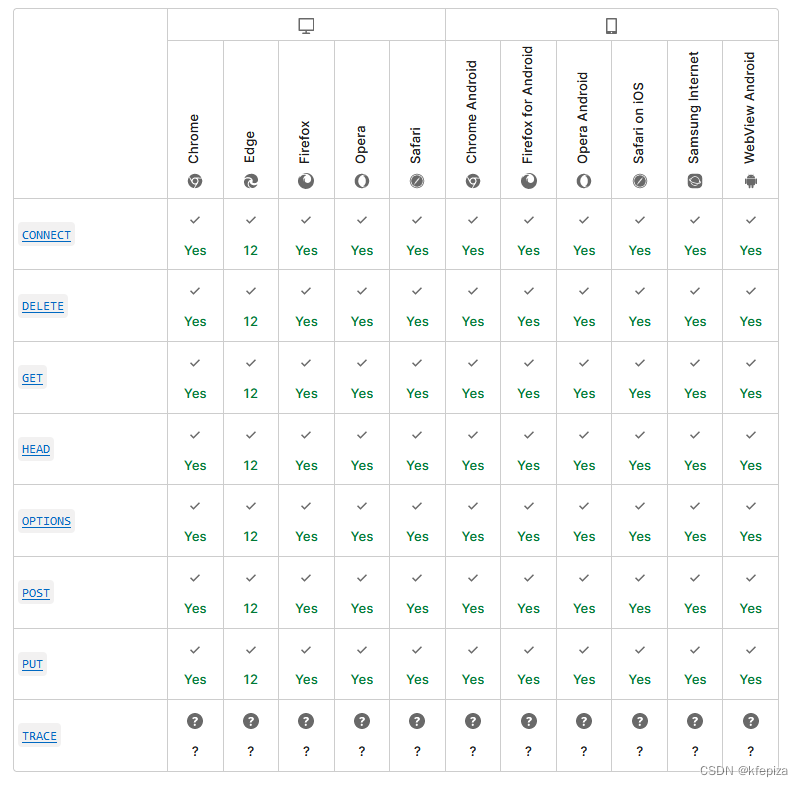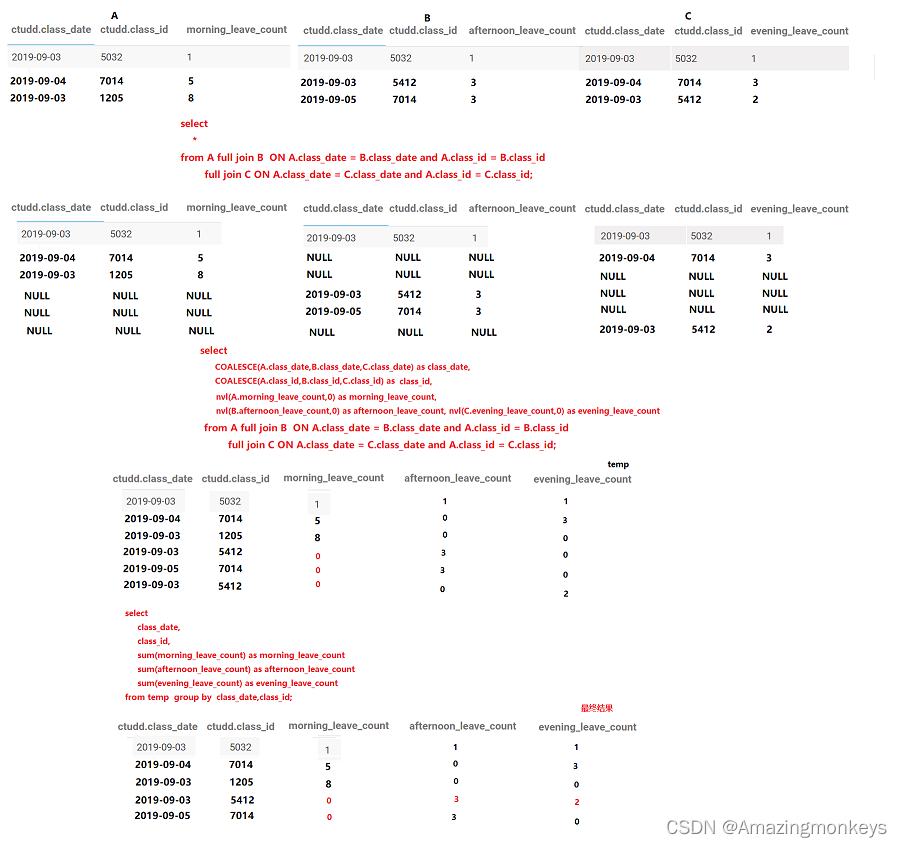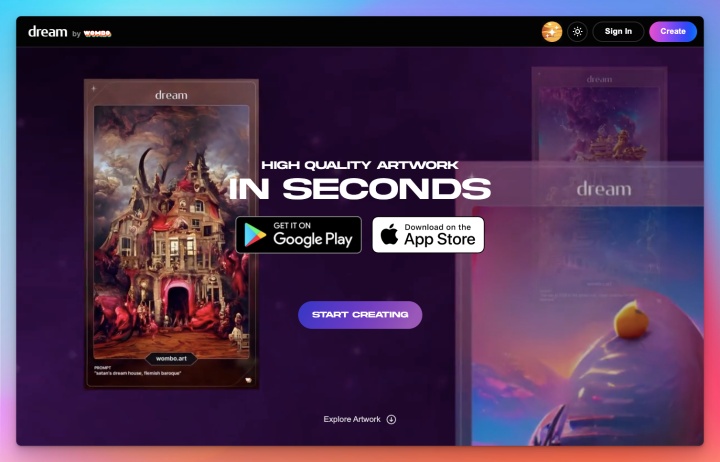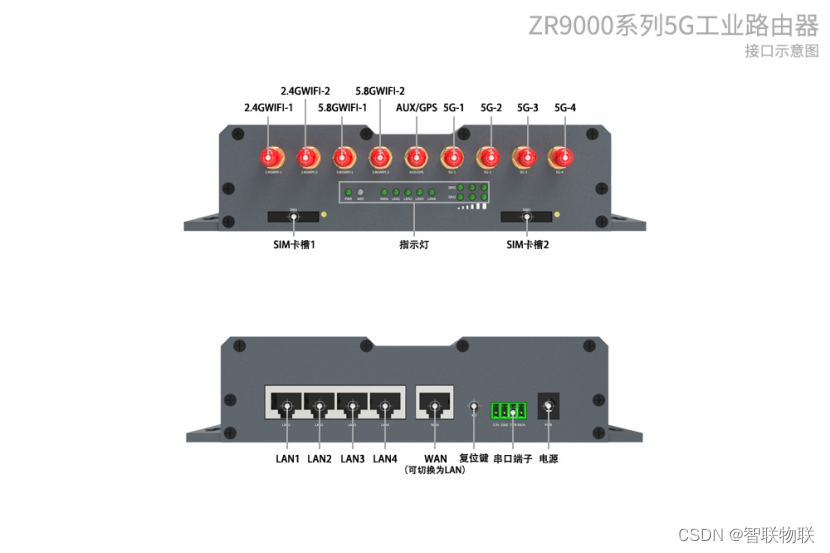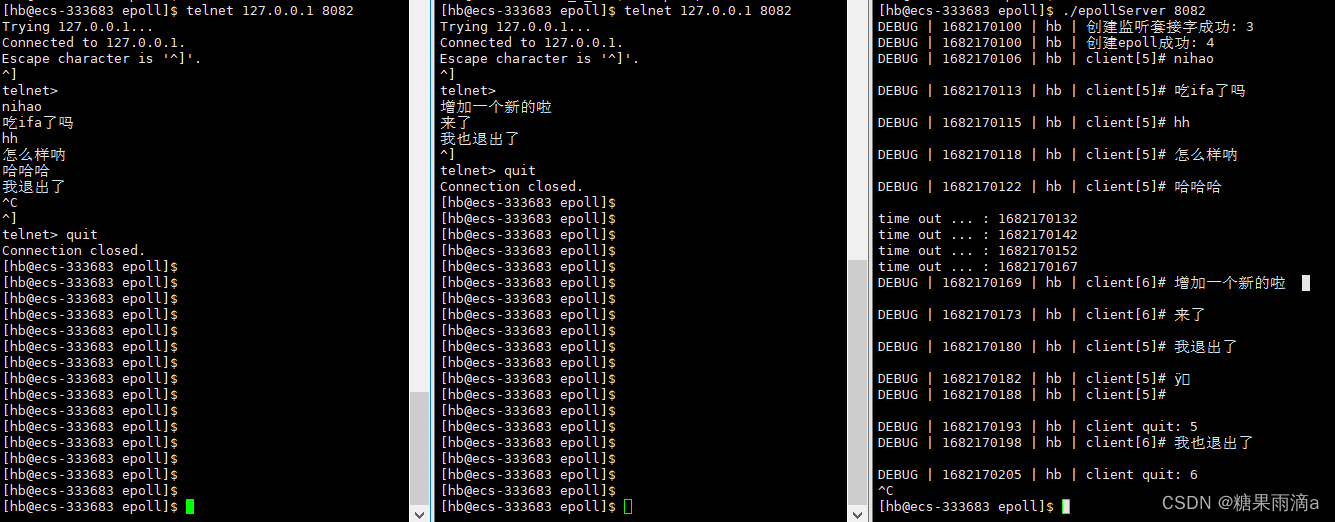1、简介
GUI的核心技术:Swing、 AWT
1、外观不太美观,组件数量偏少
2、运行需要JRE环境
为什么我们要学习?
- 组件(JTable,JList等)很多都是MVC的经典示范,学习也可以了解mvc架构。
- 工作时,也有可能遇见需要维护N年前awt/swing写的软件 (可能性极小)
- 可以写一些自己使用的软件
2、AWT
2.1 AWT介绍
- AWT(Abstract Window Toolkit),中文译为抽象窗口工具包。包括了很多类和接口,用于Java Application的GUI(Graphics User Interface 图形用户界面)编程。
- GUI的各种元素(如:窗口,按钮,文本框等)由Java类来实现。
- 使用AWT所涉及的类一般在Java.AWT包及其子包中。
- Container和Component是AWT中的两个核心类。
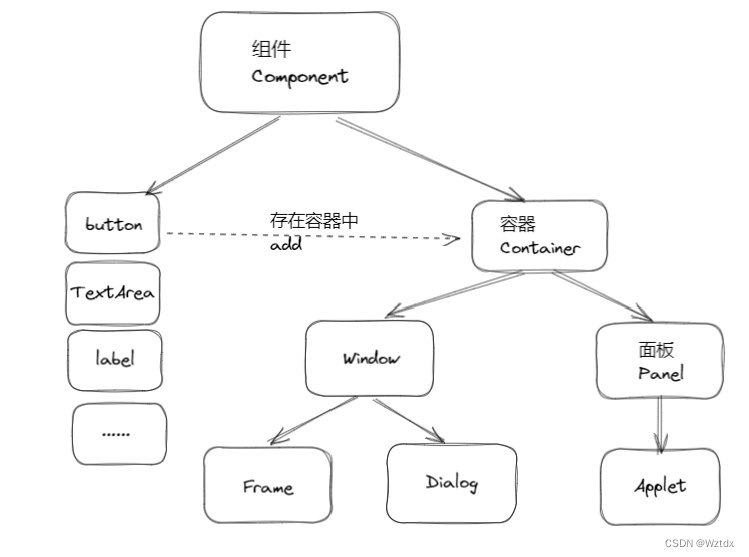
2.2 组件和容器
//GUI的第一个界面
public class TestFrame {
public static void main(String[] args) {
//这里只是在内存里面创建了一个窗口对象 还不能真正显示出来然我们看到
Frame frame = new Frame("My First Java GUI");
frame.setVisible(true);
frame.setSize(400,400);
frame.setBackground(new Color(229, 106, 106));
//设置窗体出现时的位置,如果不设置则默认在左上角(0,0)位置显示
frame.setLocation(200,200);
//窗口大小固定
frame.setResizable(false);
}
}
此时是无法通过窗口的叉来关闭窗口的,需要手动关闭程序运行
我们进行封装,一次new出多个窗口
public class TestFrame2 {
public static void main(String[] args) {
MyFrame myFrame1 = new MyFrame(100, 100, 200, 200, Color.blue);
MyFrame myFrame2 = new MyFrame(300, 100, 200, 200, Color.yellow);
MyFrame myFrame3 = new MyFrame(100, 300, 200, 200, Color.red);
MyFrame myFrame4 = new MyFrame(300, 300, 200, 200, Color.green);
}
}
class MyFrame extends Frame{
//可能存在多个窗口,需要一个计数器
static int id=0;
public MyFrame(int x,int y,int w,int h,Color color){
super("MyFrame "+(++id));
setBounds(x,y,w,h);
setVisible(true);
setBackground(color);
}
}
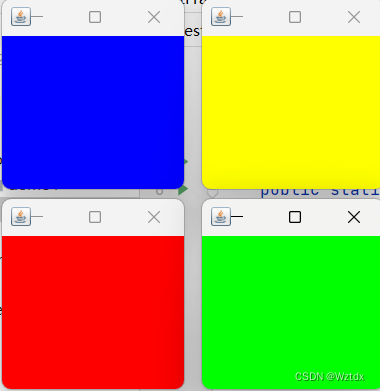
2.3 Panel
//Panel可以看成是一个空间,但是不能单独存在
public class TestPanel {
public static void main(String[] args) {
Frame frame=new Frame();
Panel panel = new Panel();
//设置布局
frame.setLayout(null);
frame.setBounds(300,300,500,500);
frame.setBackground(Color.pink);
frame.setVisible(true);
//panel设置坐标,相对于frame
panel.setBounds(50,50,100,100);
panel.setBackground(new Color(78, 210, 159));
frame.add(panel);
frame.setVisible(true);
//监听事件,监听窗口关闭事件
//适配器模式
frame.addWindowListener(new WindowAdapter() {
//窗口点击关闭时要做的事情
@Override
public void windowClosing(WindowEvent e) {
System.exit(0);
}
});
}
}
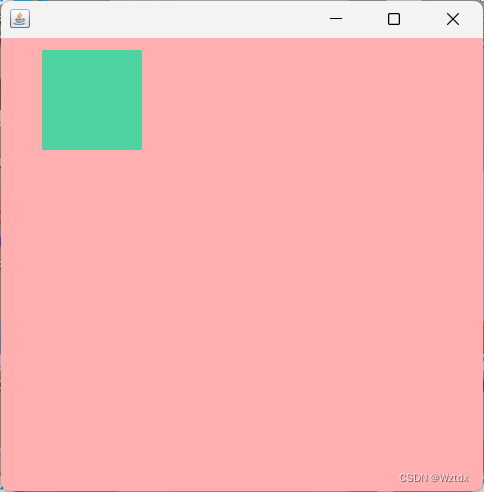
2.4 布局管理器
- 流式布局
- 东南西北中
- 表格布局
2.4.1 流式布局
public class TestFlowLayout {
public static void main(String[] args) {
Frame frame = new Frame();
Button button1 = new Button("button1");
Button button2 = new Button("button2");
Button button3 = new Button("button3");
//设置为流式布局 默认居中
frame.setLayout(new FlowLayout());
//frame.setLayout(new FlowLayout(FlowLayout.LEFT));
//frame.setLayout(new FlowLayout(FlowLayout.RIGHT));
frame.setSize(200,200);
frame.setVisible(true);
frame.add(button1);
frame.add(button2);
frame.add(button3);
}
}
2.4.2 东南西北中
public class TestBorderLayout {
public static void main(String[] args) {
Frame frame = new Frame("TestBorderLayout");
Button east = new Button("East");
Button west = new Button("West");
Button south = new Button("South");
Button north = new Button("North");
Button center = new Button("Center");
frame.add(east,BorderLayout.EAST);
frame.add(west,BorderLayout.WEST);
frame.add(south,BorderLayout.SOUTH);
frame.add(north,BorderLayout.NORTH);
frame.add(center,BorderLayout.CENTER);
frame.setSize(300,300);
frame.setVisible(true);
frame.addWindowListener(new WindowAdapter(){
@Override
public void windowClosing(WindowEvent e) {
System.exit(0);
}
});
}
}
2.4.3 表格布局
public class TestGridLayout {
public static void main(String[] args) {
Frame frame = new Frame("TestGridLayout");
Button button1 = new Button("button1");
Button button2 = new Button("button2");
Button button3 = new Button("button3");
Button button4 = new Button("button4");
Button button5 = new Button("button5");
Button button6 = new Button("button6");
frame.setLayout(new GridLayout(3,2));
frame.add(button1);
frame.add(button2);
frame.add(button3);
frame.add(button4);
frame.add(button5);
frame.add(button6);
frame.setSize(200,200);
frame.setVisible(true);
}
}
现在学会了这三个布局和面板,检验一下,完成这个案例
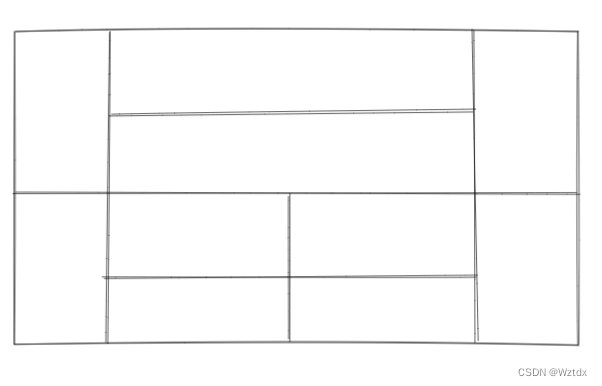
import java.awt.*;
import java.awt.event.WindowAdapter;
import java.awt.event.WindowEvent;
public class Test {
public static void main(String[] args) {
Frame frame=new Frame();
frame.setVisible(true);
frame.setSize(400,400);
frame.setBackground(Color.pink);
frame.setLocation(300,400);
frame.setLayout(new GridLayout(2,1));
//4个面板
Panel p1 = new Panel(new BorderLayout());
Panel p2 = new Panel(new GridLayout(2, 1));
Panel p3 = new Panel(new BorderLayout());
Panel p4= new Panel(new GridLayout(2, 2));
p1.add(new Button("East-1"),BorderLayout.EAST);
p1.add(new Button("West-1"),BorderLayout.WEST);
p2.add(new Button("p2-Button1"));
p2.add(new Button("p2-Button2"));
p1.add(p2,BorderLayout.CENTER);
p3.add(new Button("East-2"),BorderLayout.EAST);
p3.add(new Button("West-2"),BorderLayout.WEST);
p4.add(new Button("p4-Button1"));
p4.add(new Button("p4-Button2"));
p4.add(new Button("p4-Button3"));
p4.add(new Button("p4-Button4"));
p3.add(p4,BorderLayout.CENTER);
frame.add(p1);
frame.add(p3);
frame.addWindowListener(new WindowAdapter() {
@Override
public void windowClosing(WindowEvent e) {
System.exit(0);
}
});
}
}
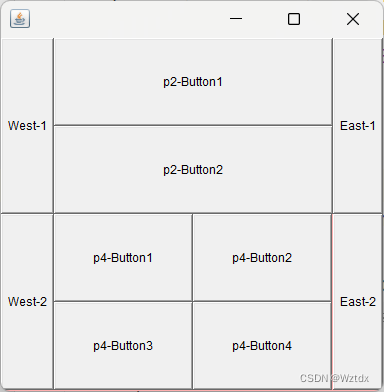
2.5 事件监听
import java.awt.*;
import java.awt.event.ActionEvent;
import java.awt.event.ActionListener;
import java.awt.event.WindowAdapter;
import java.awt.event.WindowEvent;
public class TestActionEvent {
public static void main(String[] args) {
//按下按钮,触发一些事件
Frame frame = new Frame();
Button button = new Button("Button");
//addActionListener() 需要一个ActionListener,所以我们需要构造一个ActionListener
button.addActionListener(new MyActionListener());
frame.add(button,BorderLayout.CENTER);
frame.pack();
frame.setVisible(true);
//关闭窗口
windowClose(frame);
}
//关闭窗体的事件
private static void windowClose(Frame frame){
frame.addWindowListener(new WindowAdapter() {
@Override
public void windowClosing(WindowEvent e) {
System.exit(0);
}
});
}
}
class MyActionListener implements ActionListener{
@Override
public void actionPerformed(ActionEvent e) {
System.out.println("Button");
}
}
可以看到当我们点击Button的时候,会触发事件,这个事件正是我们重写的actionPerformed方法中的内容

import java.awt.*;
import java.awt.event.ActionEvent;
import java.awt.event.ActionListener;
import java.awt.event.WindowAdapter;
import java.awt.event.WindowEvent;
public class TestActionEvent2 {
public static void main(String[] args) {
Frame frame = new Frame();
Button button1 = new Button("start");
Button button2 = new Button("stop");
button1.setActionCommand("开始");
button2.setActionCommand("停止");
button1.addActionListener(new ActionListener() {
@Override
public void actionPerformed(ActionEvent e) {
System.out.println("msg: "+e.getActionCommand());
}
});
button2.addActionListener(new ActionListener() {
@Override
public void actionPerformed(ActionEvent e) {
System.out.println("msg: "+e.getActionCommand());
}
});
frame.setLayout(new GridLayout(2,1));
frame.add(button1);
frame.add(button2);
frame.pack();
frame.setVisible(true);
//关闭窗口
windowClose(frame);
}
//关闭窗体的事件
private static void windowClose(Frame frame) {
frame.addWindowListener(new WindowAdapter() {
@Override
public void windowClosing(WindowEvent e) {
System.exit(0);
}
});
}
}

这里也可以写一个实现类来实现ActionListener,两个按钮 实现同一个监听
2.6 TextField事件监听
package com.demo2;
import java.awt.*;
import java.awt.event.ActionEvent;
import java.awt.event.ActionListener;
public class TestTextField {
public static void main(String[] args) {
new MyFrame();
}
}
class MyFrame extends Frame{
public MyFrame(){
TextField textField = new TextField();
add(textField);
//监听这个文本框输入的文字
//按下enter,就会触发这个事件
textField.addActionListener(new MyActionListener2());
//设置替换编码
textField.setEchoChar('*');
setVisible(true);
pack();
}
}
class MyActionListener2 implements ActionListener{
@Override
public void actionPerformed(ActionEvent e) {
//获得一些资源 返回一个对象
TextField field = (TextField) e.getSource();
//获取输入框的文本
System.out.println(field.getText());
//设置为空字符串
field.setText("");
}
}
2.7 简易计数器
初始版本
import java.awt.*;
import java.awt.event.ActionEvent;
import java.awt.event.ActionListener;
import java.awt.event.WindowAdapter;
import java.awt.event.WindowEvent;
public class TestCalc {
public static void main(String[] args) {
new Calculator();
}
}
//计算器类
class Calculator extends Frame{
public Calculator(){
TextField num1 = new TextField(10);
TextField num2 = new TextField(10);
TextField sum = new TextField(20);
Button button = new Button("Calc");
button.addActionListener(new MyCalculatorListener(num1,num2,sum));
Label label1 = new Label("+");
Label label2 = new Label("=");
setLayout(new FlowLayout());
add(num1);
add(label1);
add(num2);
add(label2);
add(sum);
add(button);
pack();
setVisible(true);
exit();
}
private void exit(){
addWindowListener(new WindowAdapter() {
@Override
public void windowClosing(WindowEvent e) {
System.exit(0);
}
});
}
}
//监听器类
class MyCalculatorListener implements ActionListener{
private TextField num1,num2,sum;
public MyCalculatorListener(TextField num1,TextField num2,TextField sum){
this.num1=num1;
this.num2=num2;
this.sum=sum;
}
@Override
public void actionPerformed(ActionEvent e) {
int n1 = Integer.parseInt(num1.getText());
int n2 = Integer.parseInt(num2.getText());
int n3=n1+n2;
sum.setText(String.valueOf(n3));
num1.setText("");
num2.setText("");
}
}
改造为面向对象
import java.awt.*;
import java.awt.event.ActionEvent;
import java.awt.event.ActionListener;
import java.awt.event.WindowAdapter;
import java.awt.event.WindowEvent;
public class TestCalc {
public static void main(String[] args) {
new Calculator().loadFrame();
}
}
//计算器类
class Calculator extends Frame {
TextField num1, num2, sum;
public void loadFrame() {
num1 = new TextField(10);
num2 = new TextField(10);
sum = new TextField(20);
Button button = new Button("Calc");
Label label1 = new Label("+");
Label label2 = new Label("=");
button.addActionListener(new MyCalculatorListener(this));
setLayout(new FlowLayout());
add(num1);
add(label1);
add(num2);
add(label2);
add(sum);
add(button);
pack();
setVisible(true);
exit();
}
private void exit() {
addWindowListener(new WindowAdapter() {
@Override
public void windowClosing(WindowEvent e) {
System.exit(0);
}
});
}
}
//监听器类
class MyCalculatorListener implements ActionListener {
//获取计算机这个对象,在一个类中组合另一个类
Calculator calculator = null;
public MyCalculatorListener(Calculator calculator) {
this.calculator = calculator;
}
@Override
public void actionPerformed(ActionEvent e) {
int n1 = Integer.parseInt(calculator.num1.getText());
int n2 = Integer.parseInt(calculator.num2.getText());
calculator.sum.setText(String.valueOf(n1 + n2));
calculator.num1.setText("");
calculator.num2.setText("");
}
}
改造为内部类
import java.awt.*;
import java.awt.event.ActionEvent;
import java.awt.event.ActionListener;
import java.awt.event.WindowAdapter;
import java.awt.event.WindowEvent;
public class TestCalc {
public static void main(String[] args) {
new Calculator().loadFrame();
}
}
//计算器类
class Calculator extends Frame {
TextField num1, num2, sum;
public void loadFrame() {
num1 = new TextField(10);
num2 = new TextField(10);
sum = new TextField(20);
Button button = new Button("Calc");
Label label1 = new Label("+");
Label label2 = new Label("=");
button.addActionListener(new MyCalculatorListener());
setLayout(new FlowLayout());
add(num1);
add(label1);
add(num2);
add(label2);
add(sum);
add(button);
pack();
setVisible(true);
exit();
}
private void exit() {
addWindowListener(new WindowAdapter() {
@Override
public void windowClosing(WindowEvent e) {
System.exit(0);
}
});
}
//监听器类
//内部类最大的好长就是可以畅通无阻的访问外部类的属性和方法
private class MyCalculatorListener implements ActionListener {
@Override
public void actionPerformed(ActionEvent e) {
int n1 = Integer.parseInt(num1.getText());
int n2 = Integer.parseInt(num2.getText());
sum.setText(String.valueOf(n1 + n2));
num1.setText("");
num2.setText("");
}
}
}
2.8 画笔
每个Component都有一个paint(Graphics g)用于实现绘图目的,每次重画该Component时都自动调用paint方法。
import java.awt.*;
public class TestPaint {
public static void main(String[] args) {
//在main()方法里面并没有显示调用paint(Graphics g)方法
new MyPaint().loadFrame();
}
}
class MyPaint extends Frame {
public void loadFrame(){
setBounds(200,200,600,400);
setVisible(true);
}
@Override
public void paint(Graphics graphics){
graphics.setColor(Color.red);
graphics.drawOval(100,100, 100,100);
graphics.fillOval(200,100,100,100);
graphics.setColor(Color.BLUE);
graphics.fillRect(100,200,100,100);
// 养成习惯,画笔用完 还原为最初的颜色
graphics.setColor(Color.BLACK);
}
}
2.9 鼠标监听事件
抽象类java.awt.event.MouseAdapter实现了MouseListener接口,可以使用其子类作为MouseEvent的监听器,只要重写其相应的方法即可。
import java.awt.*;
import java.awt.event.MouseAdapter;
import java.awt.event.MouseEvent;
import java.awt.event.MouseListener;
import java.util.ArrayList;
import java.util.Iterator;
public class TestMouseListener {
public static void main(String[] args) {
new MyFrame("画图");
}
}
class MyFrame extends Frame {
//存储坐标
private ArrayList points;
//画画需要画笔,需要监听鼠标当前位置,需要集合来存储这个点
public MyFrame(String title){
super(title);
setVisible(true);
setBounds(200,200,400,300);
//存储坐标
points=new ArrayList<>();
//鼠标监听器,对这个窗口
addMouseListener(new MyMouseListener());
}
@Override
public void paint(Graphics g) {
//画画,监听鼠标的事件
Iterator iterator = points.iterator();
while(iterator.hasNext()){
Point point = (Point) iterator.next();
g.setColor(Color.BLUE);
g.fillOval(point.x,point.y,10,10);
}
}
public void addPaint(Point point){
points.add(point);
}
private class MyMouseListener extends MouseAdapter {
//鼠标按压
@Override
public void mousePressed(MouseEvent e) {
//获取被监听的对象
MyFrame myFrame =(MyFrame) e.getSource();
//鼠标的坐标
myFrame.addPaint( new Point(e.getX(),e.getY()));
//每次点击鼠标都需要重新画一次
myFrame.repaint();//刷新
}
}
}
2.10 窗口监听
import java.awt.*;
import java.awt.event.WindowAdapter;
import java.awt.event.WindowEvent;
public class TestWindow {
public static void main(String[] args) {
new WindowFrame();
}
}
class WindowFrame extends Frame {
public WindowFrame(){
setBackground(Color.pink);
setBounds(100,100,200,200);
setVisible(true);
//addWindowListener(new MyWindowListener());
//使用内部类
addWindowListener(new WindowAdapter() {
//关闭窗口
@Override
public void windowClosing(WindowEvent e) {
System.out.println("退出");
System.exit(0);
}
//激活窗口
@Override
public void windowActivated(WindowEvent e) {
WindowFrame frame =(WindowFrame) e.getSource();
frame.setTitle("被激活");
System.out.println("windowActivated");
}
});
}
class MyWindowListener extends WindowAdapter{
@Override
public void windowClosing(WindowEvent e) {
//隐藏窗口
setVisible(false);
System.exit(0);//正常退出
}
}
}
2.11 键盘监听
import java.awt.*;
import java.awt.event.KeyAdapter;
import java.awt.event.KeyEvent;
public class TestKeyListener {
public static void main(String[] args) {
new KeyFrame();
}
}
class KeyFrame extends Frame {
public KeyFrame(){
setBounds(100,100,200,200);
setVisible(true);
addKeyListener(new KeyAdapter() {
@Override
public void keyPressed(KeyEvent e) {
//KeyEvent.VK_UP表示取得up键的虚拟码
//键盘中的每一个键都对应有一个虚拟码这些虚拟码在KeyEvent类里面都被定义为静态常量
//使用“类名.静态常量名”的形式访问得到这些静态常量
System.out.println(e.getKeyCode());
//获取键盘的码
if ( e.getKeyCode()==KeyEvent.VK_UP){
System.out.println("按下了上键");
}
}
});
}
}


